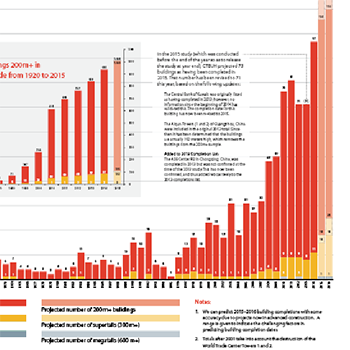Filter by
You must be a CTBUH Member to view this resource.
Gevora Hotel
101 Sheikh Zayed Road, Ahmed Abdul Rahim Al Attar Tower
Building
Completed, 2017
hotel
steel/concrete
356.3 m / 1,169 ft
75
2
528
8
You must be a CTBUH Member to view this resource.
You must be a CTBUH Member to view this resource.
Material Supplier refers to organizations which supplied significant systems/materials for a building project (e.g. elevator suppliers, facade suppliers, etc).
You must be a CTBUH Member to view this resource.
Usually takes on the balance of the architectural effort not executed by the "Design Architect," typically responsible for the construction documents, conforming to local codes, etc. May often be referred to as "Executive," "Associate," or "Local" Architect, however, for consistency CTBUH uses the term "Architect of Record" exclusively.
The Design Engineer is usually involved in the front end design, typically taking the leadership role in the Schematic Design and Design Development, and then a monitoring role through the CD and CA phases.
The Design Engineer is usually involved in the front end design, typically taking the leadership role in the Schematic Design and Design Development, and then a monitoring role through the CD and CA phases.
The main contractor is the supervisory contractor of all construction work on a project, management of sub-contractors and vendors, etc. May be referred to as "Construction Manager," however, for consistency CTBUH uses the term "Main Contractor" exclusively.
Material Supplier refers to organizations which supplied significant systems/materials for a building project (e.g. elevator suppliers, facade suppliers, etc).
Height & Data Committee Meets at 2018 Middle East Conference
20 October 2018 - Event
CTBUH Board of Trustees Travels to Hawaii
22 March 2018 - Event
Tim Griffith for KPF.jpg)
05 February 2018
2017: Skyscraper History’s Tallest, Highest- Volume, and Most Geographically Diverse Year
This 2017 Tall Building Year in Review / Tall Buildings in Numbers data analysis report shows that more buildings of 200 meters’ height or greater...
Originally planned to include residential units, the Gevora Hotel is centrally located on Sheikh Zayed Road in the financial district of Dubai and became the world's tallest all-hotel building upon completion. The façade features a simple, classic design with many windows on every floor to allow a generous amount of sunlight into the building. Each corner of the rectangular building features gold-colored façade elements, which taper into a pyramidal crown structure at the top. Builders employed a caisson foundation system during construction to help stabilize the structure.
Tim Griffith for KPF.jpg)
05 February 2018
2017: Skyscraper History’s Tallest, Highest- Volume, and Most Geographically Diverse Year
This 2017 Tall Building Year in Review / Tall Buildings in Numbers data analysis report shows that more buildings of 200 meters’ height or greater...

31 December 2014
Year in Review: Tall Trends of 2014
An All-Time Record 97 Buildings of 200 Meters or Higher Completed in 2014 and 2014 showed further shifts towards Asia, and also surprising developments in...
20 October 2018
The CTBUH Height and Data Committee met to discuss several key definitions of structural types, as well as some urban-scale considerations.
24 March 2018
The CTBUH Trustees from Chicago, New York, London, Mumbai, and Hong Kong gathered to attend the main annual Trustees meeting.
28 September 2017
The CTBUH New York Chapter kicked off its Fall networking series with an insightful evening spent examining the current progress of a historic development, Hudson Yards.
13 October 2016
The Council is pleased to announce the Top Company Rankings for numerous disciplines as derived from the list of projects appearing in 100 of the World’s Tallest Buildings.
Subscribe below to receive periodic updates from CTBUH on the latest Tall Building and Urban news and CTBUH initiatives, including our monthly newsletter. Fields with a red asterisk (*) next to them are required.
View our privacy policy